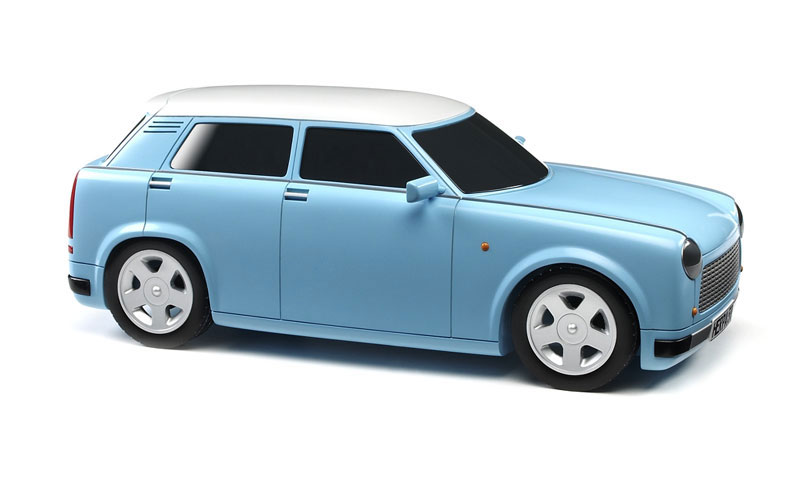Trabant Logo
Trabant nT Concept Car
Trabant Limousine
Trabant 601 Mulhouse FRA
Trabant Herpa
The Trabant is a car that was produced by former East German auto maker VEB Sachsenring Automobilwerke Zwickau in Zwickau, Sachsen. It was the most common vehicle in East Germany, and was also exported to countries both inside and outside the communist bloc. The main selling points was that it had room for four adults and luggage in a compact, light and durable shell and that it was fast (when introduced) and durable. With its mediocre performance, inefficient two-stroke engine, noxious fumes and production shortages, the Trabant is often cited as an example of the disadvantages of centralized planning; on the other hand, it is regarded with derisive affection as a symbol of the failed former East Germany and of the fall of communism (in former West Germany, as many East Germans streamed into West Berlin and West Germany in their Trabants after the opening of the Berlin Wall in 1989). It was in production without any significant changes for nearly 30 years with 3,096,099 Trabants produced in total.
Since it could take years for a Trabant to be delivered from the time it was ordered, people who finally got one were very careful with it and usually became skillful in maintaining and repairing it. The lifespan of an average Trabant was 28 years.Used Trabants would often fetch a higher price than new ones, as the former were available immediately, while the latter required the infamous long wait.
There were four principal variants of the Trabant, the P50, also known as the Trabant 500, produced 1957–1962; the Trabant 600, produced 1962–1964; the Trabant 601, produced 1963–1991; and the Trabant 1.1 produced 1990–1991 with a 1,043 cc (63.6 cu in) VW engine (making the "1.1" a slight misnomer). The engine for the Trabant 500, 600 and original 601 was a small two-stroke engine with two cylinders, giving the vehicle modest performance. At the end of production in 1989 it delivered 19 kW (26 horsepower) from a 600 cc (37 cu in) displacement. The car took 21 seconds from 0 to 100 km/h (62 mph) and the top speed was 112 km/h (70 mph). There were two main problems with the engine: the smoky exhaust and the pollution it produced—nine times the amount of hydrocarbons and five times the carbon monoxide emissions of the average European car of 2007. The fuel consumption was 7 l/100 km (40 mpg-imp; 34 mpg-US). Since the engine does not have an oil injection system, two-stroke oil has to be added to the 24-litre (6.3 U.S. gal; 5.3 imp gal) fuel tank every time the car was filled up, at a 50:1 or 33:1 ratio of fuel to oil. Gas stations of the time in countries where two-stroke engines were common served premixed gas-oil mixture from the pump. Today, owners normally carry a container of two-stroke oil in the car for this purpose. The earlier models have no fuel gauge; a dipstick is inserted into the tank to determine how much fuel remains.
The Trabant was a steel monocoque design with roof, bootlid/trunklid, bonnet/hood, bumpers/fenders and doors in Duroplast, a form of plastic containing resin strengthened by wool or cotton. This helped the GDR to avoid expensive steel imports but, in theory, did not provide much crash protection, although in crash tests it allegedly performed superior to some contemporary Western hatchbacks.
Because the car lacked a fuel pump, the fuel tank was placed high up in the engine compartment so that fuel could be fed to the carburettor by gravity; a trade-off of this design is an increased fire risk in front-end accidents. The Trabant was the second car to use Duroplast, after the "pre-Trabant" P70 (Zwickau) model (1954–1959). The duroplast was made of recycled material, cotton waste from Soviet Union and phenol resins from the East German dye industry, making the Trabant the first car with a body made of recycled material.
http://moderncar69.blogspot.com/














0 comments:
Post a Comment